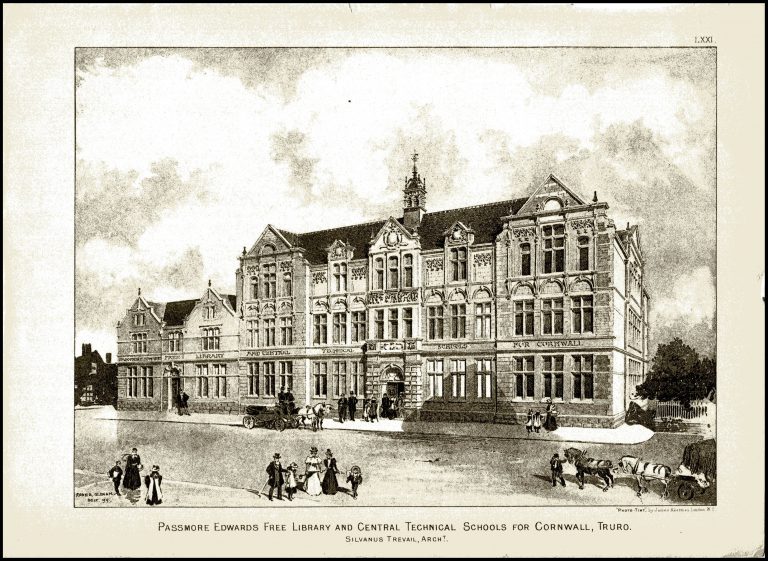Although Sir Charles Lemon, had offered to provide schooling in Truro in 1838, it was the generosity and enthusiasm of Passmore Edwards that led to the construction of firstly the Library, in 1896 and then the adjacent schools in 1899.

History
Truro was one of the five Cornish towns that benefitted from the Ferris bequest of £2000 each to provide a Free Library. The Borough Council had already started a library in the public rooms building and iut the bequest to one side.
Edwards, in offering to match the Ferris bequest, referred to this existing library as being ‘cabin’d, cribb’d and contain’d’.
Building of the new library commenced in May 1895 under the eye of Silvanus Trevail, both as architect and Mayor, and in early May 1896, crowds gathered to witness the opening. Led by the Mayor of Truro and the Mayors of most of the Cornish towns, all adorned in their robes and chains of office, a procession made its way to the new building in Pydar Street, where Edwards declared the library open. The library was dedicated to Henry Sewell Stokes, the Truro lawyer who had been Edwards’ first employer. Stokes became the Clerk to the County Council when it formed in 1894 but was also known as ‘The Cornish Poet’. He died in 1895, a month after construction of the library commenced.
In his reply to the vote of thanks Edwards said that some men had ‘no objection in writing their names in characters of blood and fire over war blasted provinces, or over bombarded and broken cities’, but he preferred to write his name, ‘if I write it at all, in characters of light over my native county and over London where I have lived and laboured’. His original intention was to open three buildings in Cornwall; the Institute at Blackwater – his place of birth, the Convalescent home at Perranporth – in memory of his mother, and the Institute at Hayle – in memory of his father. However, the three grew to seven, which he called his ’Seven Cornish Sisters in Stone‘ and as other places pleaded for an equality of treatment, the seven increased to twelve and then to nineteen, ‘and with which number his work in Cornwall would be accomplished’.The establishment of an Institution to promote technical education in Cornwall had been proposed by Sir Charles Lemon in 1836, and he offered a substantial sum of money to support it. However the offer was not taken up and although another attempt was made in the Jubilee year of 1887 it was to be more than 60 years before the Institute was created.
Again, it was Silvanus Trevail who saw an opportunity to realise Lemon’s scheme during the negotiations with Passmore Edwards over the building of Truro Free Library. There was no provision for technical education in the library and Trevail was successful in receiving a promise of £5,000 towards the cost of providing an adjacent building. The final cost was to be three times this and Trevail worked hard to gather financial support wherever is was available. But support was not universal; many distrusted Trevail’s methods and whilst other Boroughs resented “County” money being channelled into Truro, Truronians feared the Institute would become a white elephant, a financial burden on the ratepayers.
The foundation stone was laid with full Masonic ceremony. As usual a half-day holiday was declared and the crowds turned out to see the event. More than 400 masons came together from all parts of Cornwall to process the short distance from the Municipal buildings to the school site. The new Mayor, Alderman Dorrington lead the procession and conducted the proceedings, welcoming Edwards as the only freeman of the city.
During the speeches Edwards said that whereas every small town and many villages enjoyed a chapel or church, and often both, there were very few institutions where the industrial arts were taught. The Central Technical Institution, which he suggested should be dedicated to Sir Charles Lemon, was necessary in the interest of both skilled craftsmen and the community at large. England, he said, with its mineral and geographic advantages, and its judicious mixture of races should be first and foremost in the broad and ever widening field of industrial action, a sentiment as much matched to today’s challenges as of those of our late Victorian forefathers.
Completion of the schools was delayed by administrative problems but eventually the building was ready and opened by Lord Mount Edgcumbe, Lord Lieutenant and Chairman of the County Council, in October 1899. Adjacent to and in line with the library, and in the same Plymouth limestone with Bath stone dressings and of a similar English Renaissance style, the school included chemistry, physics and biology laboratories as well as metal workshop, art rooms and a museum. Trevail announced that 500 science students and a similar number of arts students had already enrolled at the Institute. In importance it was on a par with the formation of the Camborne School of Mines, established by Lemon, and Falmouth College of Art.
Current Use
Truro library still imposes itself on the street scene in this tiny Cornish City. When the adjacent Technical School was closed in the late 1970s the library service took over the whole of the building. A few years ago the County Council proposed selling off the building for retail use but fortunately this idea was abandoned, when the Trustees of the school building reminded the Council that it was they, and not the Council that controlled this half of the building.. Since then the library has been extensively restored and modernised internally and as the Truro Community Library is the flagship of the Cornwall Libraries Service.


